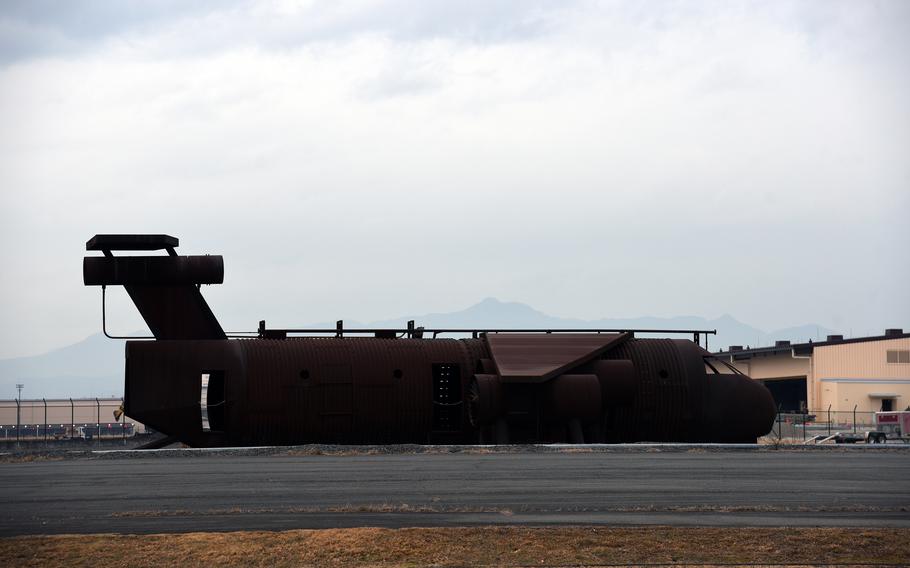
The fire training area at Yokota Air Base, Japan, includes a rusting aircraft mockup, a tower and a few wrecked cars parked west of the runway. (Seth Robson/Stars and Stripes)
YOKOTA AIR BASE, Japan — Japanese officials visited a training facility at this airlift hub in western Tokyo where firefighting foam likely overflowed into stormwater drains last summer.
The Aug. 30 leak of thousands of gallons of water was probably tainted with PFAS, so-called “forever chemicals.”
On Oct. 3, U.S. authorities notified the Japanese government of the spill “since it was highly likely” that the water flowed outside the facility, according to a statement last month from Japan’s ministries of Defense, Foreign Affairs and the Environment.
Local authorities requested an on-base inspection, according to the Dec. 20 statement, which announced the site visit that day.
A short burst of heavy rain caused approximately 12,640 gallons of water to overflow from Yokota’s fire training area onto an asphalt surface and eventually into stormwater drains, Capt. Emma Quirk, spokeswoman for Yokota’s 374th Airlift Wing, told Stars and Stripes in an Oct. 10 email.
The water probably contained residual amounts of aqueous film forming foam, she said.
The foam is a firefighting material that contains PFAS, a class of chemicals with suspected toxic properties. U.S. Forces Japan announced in November that the U.S. military had destroyed its last supplies of toxic firefighting foam at installations in the country.
PFAS, and its components, PFOS and PFOA, are found in many household products, from stainproof and waterproof fabric to nonstick cookware, according to the American Cancer Society. They are linked to an increased risk of certain tumors of the liver, testicles, breasts and pancreas.
Representatives of the Japanese government, Tokyo Metropolitan Government and the surrounding cities and towns of Fussa, Tachikawa, Akishima, Musashimurayama, Hamura and Mizuho participated in the site visit, according to the ministries’ statement.
They inspected the fire training area, according to the statement, which included a summary of what Yokota officials told the visitors. The area includes a rusting aircraft mockup, a tower and a few wrecked cars parked in an area about the size of a football field west of the runway.
The leak was visually confirmed by civil engineering units, according to the summary.
“The water leaked from the training pit in the firefighting training area, flowed through the asphalt surrounding the training pit into the surrounding gutters and then into the underground drainage pipes,” it states. “It is also possible that the water in the reservoir was blown by wind to the surface of the asphalt. However, it is highly unlikely that it flowed outside the base without passing through the stormwater drains.”
Water in the reservoir contained 1,620 nanograms of PFOS per liter when it was tested in November 2023, well above Japan’s target value of 50 nanograms per liter, according to the summary.
“Since then, no fire drills have been conducted that would have added PFOS and such to the reservoir,” it states.
Water from the Aug. 30 leak flowed into drains and, ultimately, to the southwest part of the base, according to the summary.
As a short-term measure to prevent recurrence, approximately 40,000 gallons of water were removed from the base by the end of October and incinerated at an approved facility, according to the summary.
“Considering the current water level in the reservoir, the risk of leakage is low since there will be little rainfall for the time being because it is winter,” it states.
Remaining water will be managed appropriately, and additional information will be provided through the Japanese government when a decision is made about how it will be managed, the summary states.
A USFJ spokeswoman, Marine Corps Staff Sgt. Savannah Mesimer, confirmed the site visit and briefing by Yokota officials in an email to Stars and Stripes on Tuesday.
“PFAS is a shared concern applicable to military and civilian industrial activities across Japan regardless of nationality,” she wrote. “We remain committed to protecting the health of our personnel, their families, and the surrounding communities in which we live and serve.
“We will continue to adhere to all relevant agreements, obligations and procedures as good stewards of our installations and the environment through continued and close coordination with our Government of Japan counterparts as we work together towards sustainable solutions.”